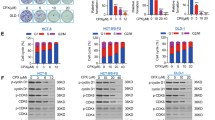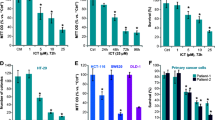Abstract
Dihydroartemisinin (DHA) is a promising anti-cancer compound capable of inhibiting proliferation and inducing apoptosis of various cancer cells, including colorectal cancer. However, the molecular mechanisms have not been well understood. This study aimed to explore the underlying mechanism of DHA-induced apoptosis in HCT-116 cells. Cell counting kit-8 assay and flow cytometry analysis confirmed that DHA inhibited proliferation, arrested cell cycle at G0/G1 phase, and enhanced apoptosis in HCT-116 cells. Fluo-3/AM-stained flow cytometry assay revealed that the intracellular Ca2+ concentration of HCT-116 cells was increased significantly after DHA treatment. Meanwhile, the activity of sarco/endoplasmic reticulum calcium ATPase (SERCA) was appeared to be reduced in a dose-dependent manner. We further detected the upregulated expression of CAAT/enhancer binding protein homologous protein (CHOP) in DHA-treated HCT-116 cells. Conversely, silencing CHOP resulted in a decrease of DHA-induced apoptosis. In addition, the expression of Bax in cytoplasm was elevated significantly along with the sharply decline of Bcl-2 expression in DHA-treated HCT-116 cells. Moreover, the distributions of Bid on mitochondria were increased, accompanied by the activation of caspase-3 in the presence of DHA. Overall, our data indicated that DHA triggered endoplasmic reticulum (ER) stress through inhibiting SERCA activity to release intracellular Ca2+ from ER, the upregulated expression of CHOP activated mitochondrial apoptosis pathway to induce apoptosis of HCT-116 cells. Therefore, our findings provide a theoretical foundation for DHA as a potential candidate in treatment of colorectal cancer.




Similar content being viewed by others
References
Ferlay, J., Shin, H. R., Bray, F., Forman, D., Mathers, C., & Parkin, D. M. (2010). Estimates of worldwide burden of cancer in 2008: GLOBOCAN 2008. International Journal of Cancer, 2010(127), 2893–2917.
Cross, A. J., Moore, S. C., Boca, S., Huang, W. Y., Xiong, X., Stolzenberg-Solomon, R., et al. (2014). A prospective study of serum metabolites and colorectal cancer risk. Cancer, 2014(120), 3049–3057.
Ju, Y. T., Kwag, S. J., Park, H. J., Jung, E. J., Jeong, C. Y., Jeong, S. H., et al. (2015). Decreased expression of heat shock protein 20 in colorectal cancer and its implication in tumorigenesis. Journal of Cellular Biochemistry, 2015(116), 277–286.
Lan, Y. T., Chang, S. C., Yang, S. H., Lin, C. C., Wang, H. S., Jiang, J. K., et al. (2014). Comparison of clinicopathological characteristics and prognosis between early and late recurrence after curative surgery for colorectal cancer. American Journal of Surgery, 2014(207), 922–930.
Chen, T., Li, M., Zhang, R., & Wang, H. (2009). Dihydroartemisinin induces apoptosis and sensitizes human ovarian cancer cells to carboplatin therapy. Journal of Cellular and Molecular Medicine, 2009(13), 1358–1370.
Wu, B., Hu, K., Li, S., Zhu, J., Gu, L., Shen, H., et al. (2012). Dihydroartiminisin inhibits the growth and metastasis of epithelial ovarian cancer. Oncology Reports, 2012(27), 101–108.
Jiao, Y., Ge, C. M., Meng, Q. H., Cao, J. P., Tong, J., & Fan, S. J. (2007). Dihydroartemisinin is an inhibitor of ovarian cancer cell growth. Acta Pharmacologica Sinica, 2007(28), 1045–1056.
Sun, H., Meng, X., Han, J., Zhang, Z., Wang, B., Bai, X., & Zhang, X. (2013). Anti-cancer activity of DHA on gastric cancer—An in vitro and in vivo study. Tumour Biology, 2013(34), 3791–3800.
Du, X. X., Li, Y. J., Wu, C. L., Zhou, J. H., Han, Y., Sui, H., et al. (2013). Initiation of apoptosis, cell cycle arrest and autophagy of esophageal cancer cells by dihydroartemisinin. Biomedicine & Pharmacotherapy, 2013(67), 417–424.
Zhang, C. Z., Zhang, H., Yun, J., Chen, G. G., & Lai, P. B. (2012). Dihydroartemisinin exhibits antitumor activity toward hepatocellular carcinoma in vitro and in vivo. Biochemical Pharmacology, 2012(83), 1278–1289.
Chen, H., Sun, B., Wang, S., Pan, S., Gao, Y., Bai, X., & Xue, D. (2010). Growth inhibitory effects of dihydroartemisinin on pancreatic cancer cells: Involvement of cell cycle arrest and inactivation of nuclear factor-kappaB. Journal of Cancer Research and Clinical Oncology, 2010(136), 897–903.
Chen, H., Sun, B., Pan, S. H., Li, J., Xue, D. B., Meng, Q. H., & Jiang, H. C. (2009). Study on anticancer effect of dihydroartemisinin on pancreatic cancer. Zhonghua Wai Ke Za Zhi, 2009(47), 1002–1005.
Paraskevas, G. P., Kapaki, E., Libitaki, G., Zournas, C., Segditsa, I., & Papageorgiou, C. (1997). Ascorbate in healthy subjects, amyotrophic lateral sclerosis and Alzheimer’s disease. Acta Neurologica Scandinavica, 1997(96), 88–90.
Lu, J. J., Chen, S. M., Zhang, X. W., Ding, J., & Meng, L. H. (2011). The anti-cancer activity of dihydroartemisinin is associated with induction of iron-dependent endoplasmic reticulum stress in colorectal carcinoma HCT116 cells. Investigational New Drugs, 2011(29), 1276–1283.
Lu, M., Sun, L., Zhou, J., & Yang, J. (2014). Dihydroartemisinin induces apoptosis in colorectal cancer cells through the mitochondria-dependent pathway. Tumour Biology, 2014(35), 5307–5314.
Wang, G., Yamasaki, K., Daiho, T., & Suzuki, H. (2005). Critical hydrophobic interactions between phosphorylation and actuator domains of Ca2+-ATPase for hydrolysis of phosphorylated intermediate. Journal of Biological Chemistry, 2005(280), 26508–26516.
Ontikatze, T., Rudner, J., Handrick, R., Belka, C., & Jendrossek, V. (2014). Dihydroartemisinin is a hypoxia-active anti-cancer drug in colorectal carcinoma cells. Frontiers in Oncology, 2014(4), 116.
Sun, S., Li, W., Zhang, H., Zha, L., Xue, Y., Wu, X., & Zou, F. (2012). Requirement for store-operated calcium entry in sodium butyrate-induced apoptosis in human colon cancer cells. Bioscience Reports, 2012(32), 83–90.
Dolai, S., Pal, S., Yadav, R. K., & Adak, S. (2011). Endoplasmic reticulum stress-induced apoptosis in Leishmania through Ca2+-dependent and caspase-independent mechanism. Journal of Biological Chemistry, 2011(286), 13638–13646.
Monteith, G. R., McAndrew, D., Faddy, H. M., & Roberts-Thomson, S. J. (2007). Calcium and cancer: targeting Ca2+ transport. Nature Reviews Cancer, 2007(7), 519–530.
Guerrero-Hernandez, A., Dagnino-Acosta, A., & Verkhratsky, A. (2010). An intelligent sarco-endoplasmic reticulum Ca2+store: Release and leak channels have differential access to a concealed Ca2+pool. Cell Calcium, 2010(48), 143–149.
Guerrero-Hernandez, A., Leon-Aparicio, D., Chavez-Reyes, J., Olivares-Reyes, J. A., & DeJesus, S. (2014). Endoplasmic reticulum stress in insulin resistance and diabetes. Cell Calcium, 2014(56), 311–322.
Moenner, M., Pluquet, O., Bouchecareilh, M., & Chevet, E. (2007). Integrated endoplasmic reticulum stress responses in cancer. Cancer Research, 2007(67), 10631–10634.
Shi, J. M., Bai, L. L., Zhang, D. M., Yiu, A., Yin, Z. Q., Han, W. L., et al. (2013). Saxifragifolin D induces the interplay between apoptosis and autophagy in breast cancer cells through ROS-dependent endoplasmic reticulum stress. Biochemical Pharmacology, 2013(85), 913–926.
Uhlemann, A. C., Cameron, A., Eckstein-Ludwig, U., Fischbarg, J., Iserovich, P., Zuniga, F. A., et al. (2005). A single amino acid residue can determine the sensitivity of SERCAs to artemisinins. Nature Structural & Molecular Biology, 2005(12), 628–629.
Quick, Q. A., & Faison, M. O. (2012). CHOP and caspase 3 induction underlie glioblastoma cell death in response to endoplasmic reticulum stress. Experimental and Therapeutic Medicine, 2012(3), 487–492.
Szegezdi, E., Logue, S. E., Gorman, A. M., & Samali, A. (2006). Mediators of endoplasmic reticulum stress-induced apoptosis. EMBO Reports, 2006(7), 880–885.
Woo, K. J., Lee, T. J., Lee, S. H., Lee, J. M., Seo, J. H., Jeong, Y. J., et al. (2007). Elevated gadd153/chop expression during resveratrol-induced apoptosis in human colon cancer cells. Biochemical Pharmacology, 2007(73), 68–76.
McCullough, K. D., Martindale, J. L., Klotz, L. O., Aw, T. Y., & Holbrook, N. J. (2001). Gadd153 sensitizes cells to endoplasmic reticulum stress by down-regulating Bcl2 and perturbing the cellular redox state. Molecular and Cellular Biology, 2001(21), 1249–1259.
Markan, S., Kohli, H. S., Joshi, K., Minz, R. W., Sud, K., Ahuja, M., et al. (2009). Up regulation of the GRP-78 and GADD-153 and down regulation of Bcl-2 proteins in primary glomerular diseases: A possible involvement of the ER stress pathway in glomerulonephritis. Molecular and Cellular Biochemistry, 2009(324), 131–138.
Gao, X., Luo, Z., Xiang, T., Wang, K., Li, J., & Wang, P. (2011). Dihydroartemisinin induces endoplasmic reticulum stress-mediated apoptosis in HepG2 human hepatoma cells. Tumori., 2011(97), 771–780.
Scorrano, L., Oakes, S. A., Opferman, J. T., Cheng, E. H., Sorcinelli, M. D., Pozzan, T., & Korsmeyer, S. J. (2003). BAX and BAK regulation of endoplasmic reticulum Ca2+: A control point for apoptosis. Science, 2003(300), 135–139.
Kaufman, R. J. (1999). Stress signaling from the lumen of the endoplasmic reticulum: Coordination of gene transcriptional and translational controls. Genes & Development, 1999(13), 1211–1233.
Pahl, H. L. (1999). Signal transduction from the endoplasmic reticulum to the cell nucleus. Physiological Reviews, 1999(79), 683–701.
Kroemer, G., Galluzzi, L., & Brenner, C. (2007). Mitochondrial membrane permeabilization in cell death. Physiological Reviews, 2007(87), 99–163.
Zha, J., Weiler, S., Oh, K. J., Wei, M. C., & Korsmeyer, S. J. (2000). Posttranslational N-myristoylation of BID as a molecular switch for targeting mitochondria and apoptosis. Science, 2000(290), 1761–1765.
Acknowledgments
This study was supported by a Grant from the National Natural Science Foundation of China (Grant No.: 81250020).
Author information
Authors and Affiliations
Corresponding author
Additional information
Min Lu and Luhaoran Sun contributed equally to this work.
Rights and permissions
About this article
Cite this article
Lu, M., Sun, L., Zhou, J. et al. Dihydroartemisinin-Induced Apoptosis is Associated with Inhibition of Sarco/Endoplasmic Reticulum Calcium ATPase Activity in Colorectal Cancer. Cell Biochem Biophys 73, 137–145 (2015). https://doi.org/10.1007/s12013-015-0643-3
Published:
Issue Date:
DOI: https://doi.org/10.1007/s12013-015-0643-3




